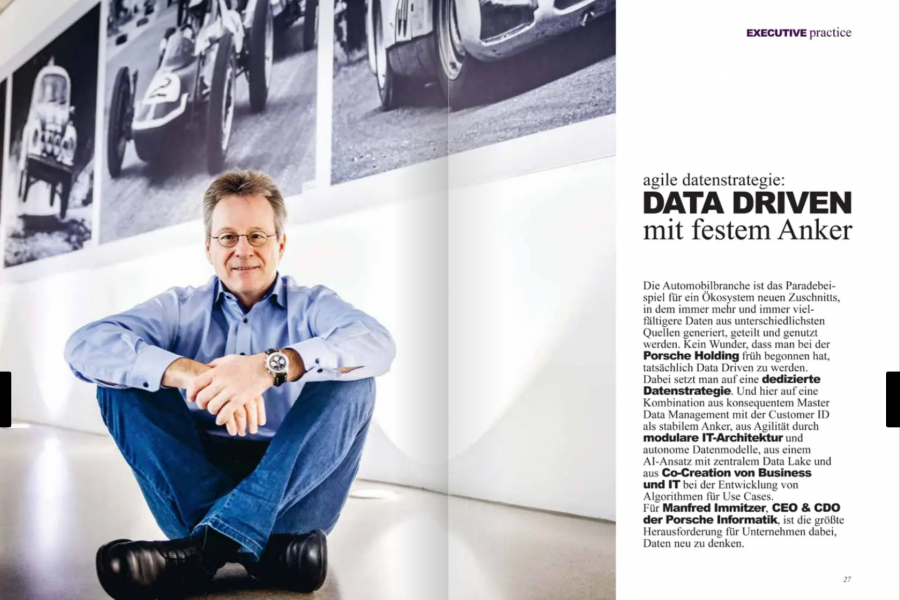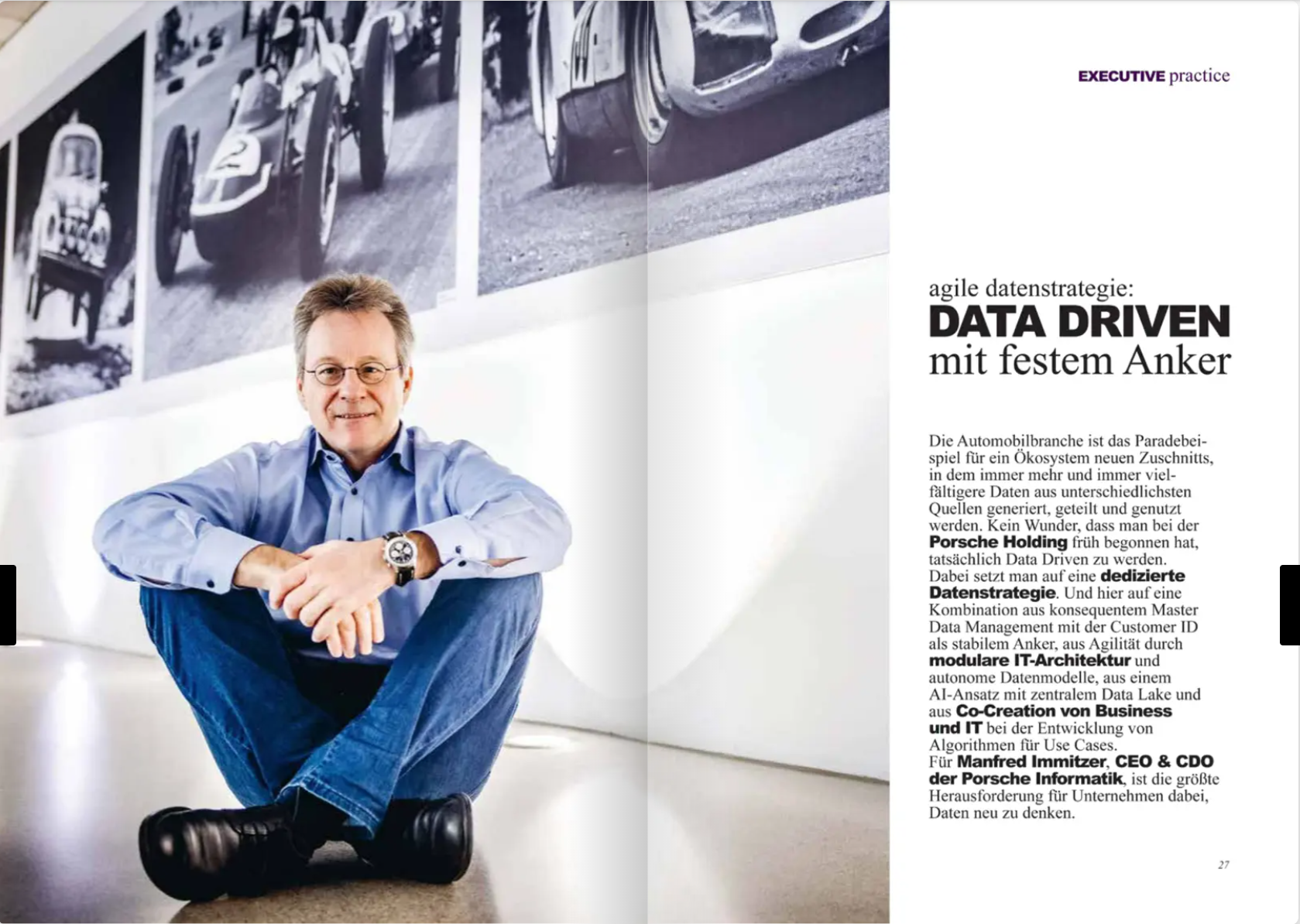
In its Q2 2022 issue, CIO GUIDE | CDO GUIDE interviewed our CEO and CDO Manfred Immitzer on the topic of data economy and its importance in the further development of Porsche Holding. With the kind permission of the publisher, we are reprinting the article here for your reading pleasure.
The automotive industry is a prime example of a new type of ecosystem where increasingly diverse data from many different sources is generated, shared and used. It is no wonder that Porsche Holding started to become truly “data driven” very early on. The company adopted a dedicated data strategy based on a combination of consistent master data management with the customer ID as a stable anchor, agility through modular IT architecture with autonomous data models, an AI approach with a central data lake, and business and IT co-creation when developing algorithms for use cases. Manfred Immitzer, CEO & CDO of Porsche Informatik, feels the biggest challenge for companies is to rethink data.
It all started with the car. The focus was on the car as a product. It was bought or financed, then repaired and eventually reached the end of its life cycle. This concept was very successful for a long time – but now the car is becoming smart and part of a networked world, the Internet of Things. A connected car produces and communicates ever growing amounts of increasingly diverse information. And it constitutes the core of a prime example of a new type of data ecosystem in which leading industries such as the automotive sector are rethinking and retooling at almost all ends – to become data driven.
One of the main drivers of this trend is the customer. Today customers know exactly what they want – they still want great cars, but they want more than that. Today, it’s all about embedding mobility into people’s lifestyles. And it’s about information.

Manfred Immitzer, (c) digbizleader, Doris Wild
“Our customers want relevant information at the touch of a button, in real time, on their smartphone,” says Manfred Immitzer, CEO & CDO of Porsche Informatik. “And they trust our ability to anticipate what generates real added value.”
Given the car’s dynamic ecosystem, which trend researchers describe as CASE (Connected, Autonomous, Shared and Electric), this is becoming a real challenge. Digitalization is changing the linear business model where manufacturers sell to wholesalers who sell to retailers who sell to the customer and transforming it into an ecosystem in which many parts of this value chain interact directly with the customer.
The customer journey in this omnichannel world still takes them from a website to a dealership, but they can also get there from various self-service apps, portals and other entry points. Even importers are increasingly addressing customers directly, and OEMs are communicating with them via the connected car itself. By offering items such as features on demand, over-the-air updates and predictive maintenance, OEMs are establishing new business models and increasingly positioning themselves as service providers.
An agile data ecosystem is about offering a seamless customer experience
The crux of multipolar communication throughout the networked world is that not only the participants, but also the information flows must be networked in order to effectively turn them into added value.
“Today, a good customer experience has to be seamless,” states Immitzer with conviction. “If the information that a customer passes on via an app or discusses in a car dealership is not processed properly in all programs, it leads to inconsistent data and aggravates customers. This can ultimately result in a company losing these customers.” Enormous amounts of data are generated in the sales process, in customer service, in automotive financial services and also by the car itself. A decisive factor for success is making this data transparent, distributing it and using it. This data opens up completely new possibilities, virtually a free ride into the future.
Manfred Immitzer feels there is one key prerequisite to finding the best path: in addition to the corporate, digital and IT strategies, there must be a dedicated data strategy that not only guarantees that the data is used, but also that data protection laws are complied with. Porsche Holding began to establish this early on – more than five years ago – at a time when most people considered “data driven” to be simply another adjective for digitalization. Today it is becoming increasingly clear that it is much more than that, and Porsche Holding has already come a long way in being data driven – and can now continue to build on this basis. “The company’s data strategy is our guide for future decisions and developments within Porsche Informatik – sort of like a manual.”
________________________
Today, a good customer experience has to be seamless. If the information that a customer passes on via an app or discusses in a car dealership is not processed properly in all programs, it leads to inconsistent data and aggravates customers.”
________________________
However, there are no easy shortcuts on a data-driven journey. On the contrary, a stable basis is the first requirement. For the CEO & CDO of Porsche Informatik, one thing is certain: “Our basis is consistent master data management with a unique customer ID as the central element. In the growing stream of data from many different data sources, the unique customer ID is our secure anchor for our customer data, protecting our single source of truth, both for new business opportunities and for compliance with the GDPR.”
This ID is used to store the golden record (name, contact data, etc.). But this data record is not “buried” in a CRM or ERP system. It remains autonomous as a system-independent and standalone element of the company’s data architecture.
Not only the master data but also the transaction data of actions such as searching, buying and ordering are attached to this anchor. This creates a more comprehensive profile that makes it possible to explicitly offer customers additional services, information and benefits – naturally only to those customers who give their consent to the storage, use and linking of their data in accordance with the GDPR. But even if the data can only be used anonymously, valuable patterns can be recognised, and decision-making aids can be derived from it. “The more data we have, the better predictions can be made from it,” points out Manfred Immitzer. “If you serve millions of customers worldwide like we do, even anonymised data is very meaningful.”

Manfred Immitzer, (c) digbizleader, Doris Wild
He soberly brings anyone who is now looking forward to the wonderful prospect of the many utilisation options back down to earth – or rather to the path, which is not always smooth and even. “Generating and collecting a lot of data is no great achievement in and of itself. The real achievement is deriving added value from it. This requires connecting to older systems and ensuring a consistent data structure and the necessary data quality. This usually takes more than two or three months.
If, for example, a company uses a dealer management system, as Porsche Informatik does, then the only additional data needed other than the golden record is the data relevant to after-sales processes. That is also where the master data is hosted because a transaction-based system would otherwise have a performance problem. The data is not physically located in a single place in the system, but it is in the sense of a single source of truth. If a customer makes changes via the internet portal or their customer account, the data is updated there and synchronised in all systems via the central master data management.
Constant change requires rapidly adaptable data concepts and architecture concepts
The data architecture and the anchor always remain the same, even if the system landscape changes – and Immitzer is certain that it will change more often and faster in the future: “That is precisely one of the advantages of digitalization: the possibility to constantly change and adapt processes – up to and including entire business models. The entire IT architecture must be modular and swiftly adaptable. The previous paradigm of building a new system for every new business model with the associated time and budget expenditure simply no longer works.”
Porsche Informatik demonstrates that autonomous, agile concepts and central structural elements are not necessarily mutually exclusive. For example, the approach to processing and linking data is based on AI and machine learning mechanisms. A data lake has been set up and is fed with use-case-related data in a wide variety of formats.
This has created the necessary architectural capabilities for big data analytics and the possibility of combining the vast amounts of diverse data into applications by using algorithms and feeding the data back to where added value can be achieved. Business and IT co-create algorithms, mainly using open source technologies. “Generating algorithms in the data environment is a creative process,” emphasises Manfred Immitzer. “What is often too rarely recognised is that business and IT not only need to collaborate, but actually develop use cases together.”
Algorithm development as creative co-creation between business and IT
The results from the data lake are usually not intended for end-users. They are input for end-user applications, such as a CRM system where aftersales data can provide additional personalisation possibilities. Or a logistics system that benefits from optimised forecasts. Porsche Holding supplies all of Europe from two logistics centres. The warehouses contain an enormous variety of spare parts that have to be at each location in Europe within clearly defined times as needed. “If a new algorithm allows us to improve by just a few per cent, that is already a significant economic impact,” emphasizes Immitzer.
________________________
“When an organisation that has been ticking along on a process basis switches to thinking in terms of data, then business has to get out of its comfort zone. And that challenges not only the employees, but also the company as a whole.”
________________________
And at the latest when business and IT have to co-create to develop algorithms for concrete use cases, it becomes clear that data is not an IT matter but a business matter that can be used to expand business capabilities.
“The responsibilities have become crystal clear. The best example is that data governance and data ownership are clearly the responsibility of business,” states the CEO & CDO of Porsche Informatik. “This is an essential prerequisite for the new mindset that is needed here. A radical rethinking process is necessary to develop and establish this mindset. When an organisation that has been ticking along on a process basis switches to thinking in terms of data, then business has to get out of its comfort zone. And that challenges not only the employees, but also the company as a whole.
When we started this data strategy for the entire company more than five years ago, the challenges were primarily seen on the IT side – and that was also the unanimous opinion of analysts. That has changed. Today, data management is primarily a challenge for change management in business.”
Text: Julia Weinzettl; Photos: Doris Wild


